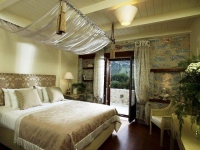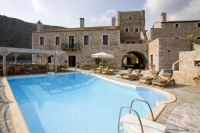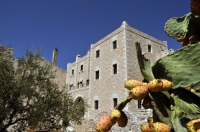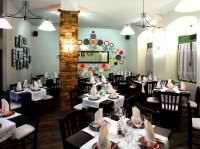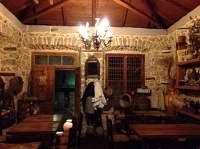Discover Lakonian Mani: Ten Suggestions
The more you visit Mani, the more you want to return to it, and the more you return to Mani, the more new things you discover there. Full of history from as far back as the Homeric years, including a significant contribution to the Greek liberation struggles, Mani has always been insubordinate, free, and unique.
It's hard to describe Mani as just a tourist destination without combining your visit there with everything that accompanies it: the residents, landscape, houses with towers, megalithic buildings, Byzantine churches and monasteries, archaeological sites, castles and historic sites, caves, natural beauty, and of course the sea and its beaches. All of these are so numerous that it is difficult, if not impossible, to fit it all into one guide.
There are also internationally known attractions such as the Homeric village of Oitylo or Itylo, the castle town of Vatheia, Diros Cave, the archaeological site of Tainaro, and the cities of Gythio and Areopoli, which are presented on Exploring Greece and about which one can find a wealth of information. In this list of suggestions, however, we want to showcase less known but equally beautiful, interesting, and important landmarks of Mani in Lakonia based on our own experience.
Perhaps the best beach in Mani in terms of its natural environment: bluegreen waters in a landscape of wild beauty, with access mainly by sea (from Porto Kagio; ask at the beautiful seaside Akrotiri Taverna, which also offers rooms for rent). For ardent hikers, access is possible via a rough trail of about 2,800 meters, or 60 to 90 minutes, from the village of Piontes (also called Akrogiali), which starts at the old Georgopoulianiko Monastery of Our Savior. Along the way, we find the Cave of Kokas.
Ten kilometers down the road from Gythio to Areopoli, we find the Passavas Castle, which was built in 1254 by Baron de Neuilly on the site of the ancient town of Las.
On the way from Areopoli to Gythio, there is a sign across from a taverna that shows where we should leave the car and start the short climb to the castle (15-20 minutes; see the map). On top of a low hill (125-150 meters) with a beautiful view of southeast Mani, we will come across the ruins of the historic castle among the weeds: ruins abandoned over time that remind us of a distant era, ruins that are beginning to disappear among the vegetation in the landscape of Mani.
3) The Desolate Settlement of Polyaravos
Ruins of a small fortified mountain village at the summit of the forested side of Mount Ziziali; at 840 meters, it is the highest Mani village in the Taygetos range. Here in Polyaravos, on August 28, 1826, the people of Mani achieved a glorious victory over Ibrahim and his 6,000 Turkish and Egyptian fighters after a three day battle. This victory was very important, because it essentially compelled Ibrahim to abandon any further attempt to subdue Mani.
Since the ruins of this settlement stand as a testament to the heroism and defiant spirit of Mani, they are worth visiting.
4) The Cave of Zacharias in Skoufomiti
Skoufomiti and Polyaravos were the two villages in Mani that were built in fortified mountain positions on Mount Taygetos. The castle of the famous thief of Moria, Captain Zacharias Barbitsiotis (1759 – 1805), was in historic Skoufomiti.
Below the Castle of Zacharias, there is a cave (the hole of Zacharias) with a few stalactites remaining. The cave was used as a hideout by Zacharias, and it is said that it was connected to five neighboring villages as well as his castle.
5) The Peninsula of Skopa and Sykia Beach
Like a painting by Bob Ross, the gorgeous Cove of Kolokythia emerges before us with the captivating Skopa Peninsula, east of Kotronas. The area was the ancient seaport of Pyrrichos and the marine citadel of ancient Tefthronis. Today we can see a few remains which date back to the Roman era--the Roman baths. The small Church of Saint Nicholas was built on top of the ancient temple of Issoria Artemis.
Well hidden at the southeast tip of the peninsula, about 150 meters south of the small Church of Saint Nicholas, Sykia Beach is a very beautiful beach with dark pebbles and dark blue water. The name “Sykia” (which means “fig tree”) comes from the tree at the beginning of the path that descends to the beach.
6) The Megalithic Village of Agios Georgios at Makrynaros
A beautiful but exhausting path begins after Flomochori, just before Zoufa (near a small cemetery with a little church). After a 45 to 60 minute climb, it leads us to the solitary, abandoned medieval megalithic settlement of Agios Georgios on Mount Makrynaros, with its giant homes made with large stones without mortar and the Church of Saint George (Agios Georgios), in the Sangia mountain range.
It is the clearest and most striking example of megalithic architecture. At 390 meters altitude, the view from the village toward the Lakonian Gulf is gorgeous.
7) Ascent to Kournos Monastery and Ancient Aigila
One of the most beautiful outings in Mani includes a visit to the archaeological site of Kournos with its Byzantine Monastery of the Virgin Mary of Kournos, which was built before the 16th century, and ancient Aigila. To reach the archaeological site of Kournos, follow the marked ancient path that starts at the edge of the settlement of Vigla. It takes approximately one hour to cover the distance of 3 kilometers, given the altitude change of 300 meters.
A path begins at the monastery of Kournos that will lead us to the site of ancient Aigila in twenty minutes. Along the way, we can admire the beautiful view of the Lakonian Gulf. We will find a few abandoned remains of ancient Aigila at Kionia or Vasilikes Petres (which means Royal Stones). According to Pausanias, this was the site of the sacred temple of Demeter (or Dimitra), which was demolished by order of the abbot of the Kournos monastery in the 16th century.
8) A Visit to the Castle of Ano Poula
Historians disagree to this day about where the Castle of Maini really was. Three basic scenarios currently exist. One locates it at the Castle of Itylo, the second at the edge of the peninsula at Tigani, west of Mezapos, and the third west of Kipoula on the plateau of Ano Poula that leads north to the steep cliffs of Mesalimano.
Although the third possibility may be the least likely, the opinion that the acropolis of ancient Messa (today’s Mezapos) was built in Ano Poula still seems most prevalent.
In any case, it is worth the short climb to the castle ruins to enjoy the exquisite panoramic views and to try to walk the rough, obstructed paths that lead us to the ruins of Byzantine churches.
The most important of these are the Byzantine churches of Saint George (the smallest) and Saint Theodore (the largest) on the eastern side of the castle of Ano Poula. The frescoes date back to different periods (from the 11th to the 14th century). Unfortunately, the churches have been abandoned completely, with their interiors partially destroyed. To find them, follow the path from the church of Saint Nikitas after the cemetery of Kipoula to the entrance of the castle, then head north along the eastern side. Access is difficult and tiring despite the short distance (about 600 meters from the entrance), because the trails have been obstructed by piles of stones.
9) A visit to Bardounochoria, Bardounia Castle, and the Stara Bridge in Smynos Gorge
The Bardounochoria (Bardouno villages) are located north of the villages of Mani. The whole area around the castle of Bardounia in Agios Nikolaos was called Vardounia or Bardounia. Standing on the rock above the gorge of the Smynos River, the half destroyed walls of the once mighty medieval Bardounia Castle are still striking. The original Venetian architecture of the castle was altered by notable Turkish additions.
There was and is disagreement about whether some or all of these villages are part of Mani, but wherever they belong, one thing is certain: they are unique places with an important history, and we strongly recommend that you visit them.
One basic distinction that is made in Bardounochoria is between those that were conquered by the Turks (Tourkobardounochoria) and the unsubdued Greeks. The border between the two areas was the bridge of Stara southeast of Melissa. Now a preserved monument of important architectural value, the bridge connects the banks of the ancient river Smynos at the point where the river narrows considerably. It is believed to have been built 400 to 500 years ago.
10) Dirt Road from Skyfianika to Kryoneri, Tsigkou Monastery
A nice, passable ten kilometer dirt road starts at Skyfianika and ends just before Kryoneri (on the road from Itylo to Kryoneri), passing by the Tsigkou Monastery (which is also called the Petrouliano Monastery).
We will find the monastery in a very beautiful landscape about 3 kilometers from Kryoneri, hidden across from a shepherd's hut on our right. It is a Byzantine monastery (1537 AD) dedicated to the Virgin Mary.


